Classic English Scones
Classic English Scones are light and airy with a slight crumble. A very British treat to which you can add different dried and fresh fruit. Usually served with afternoon tea and clotted cream, these are the very British round version, different to the American triangle ones.
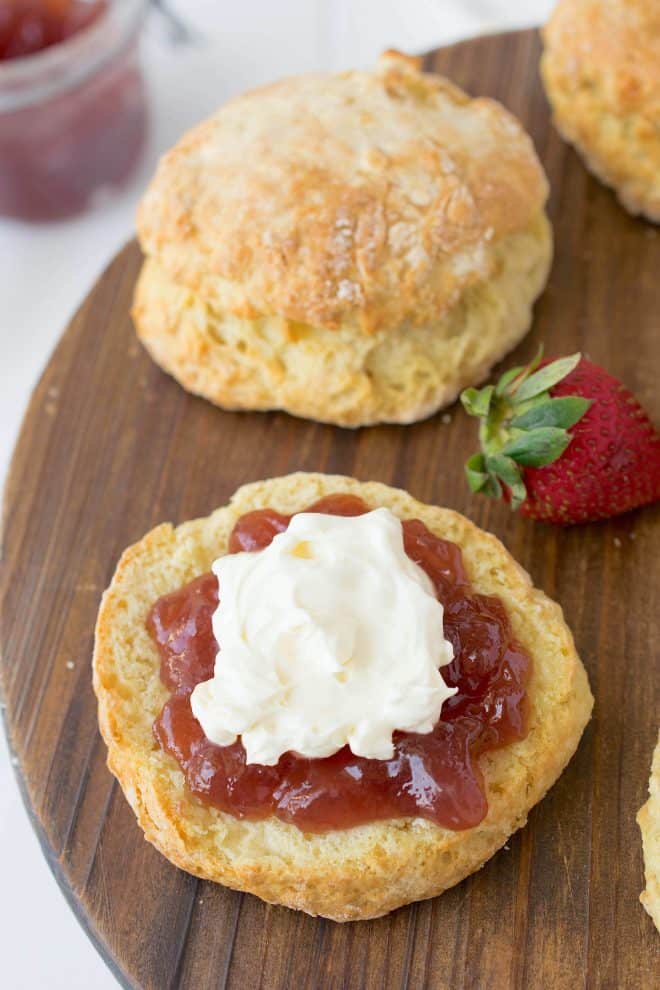
Scones are always best when freshly made. I love all types of scones, but there are times where I just want it in its purest form with nothing added because I love the toppings. Speaking of the toppings, read on about the very English clotted cream.

What is clotted cream?
Where it is a very unappealing name, it is the creamiest cream made from the best Devon cows milk. In a nutshell, cream is cooked stovetop or oven until the cream ‘clots’ and forms a thick layer on the top and as a result the cream is skimmed off the top and enjoyed on scones.
To read a more comprehensive history of clotted cream and afternoon tea, visit my post on Clotted Cream for Afternoon Tea.
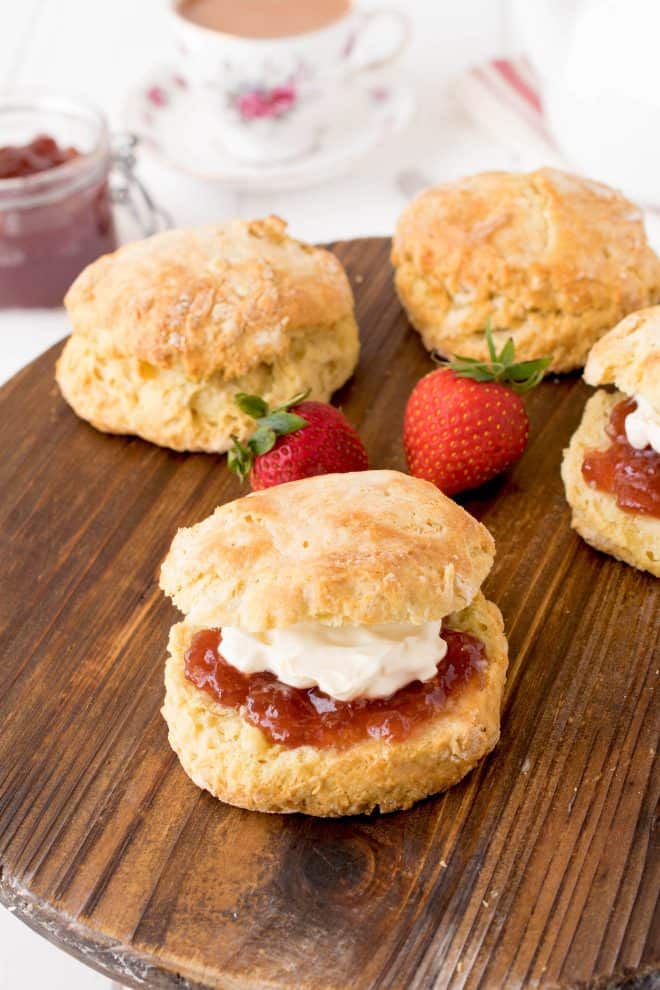
There are many theories that go into making the perfect scones, for instance when cutting out the circles out of the dough, don’t twist or they will rise crooked. This is not the end of the world if they are crooked, it just makes them look more homemade.
Cold butter is a must for scones
When baking scones, cold butter is one of the reason you get fluffy, well-risen scones. The reason for this is, the little bits of butter are evenly distributed throughout the dough will leave flaky layers in the scones.
Freezing of the butter
Yes, I freeze the butter for 15-20 minutes before using. I also grate the butter (using a large box grater) into the flour which creates little bits of butter that get well distributed into the flour and you don’t have to spend too much time mixing in.
There’s also a question of do you add jam first to the scone then the cream on top of that. Eat it how you want to, but I do like jam first, then the cream and this is how the Queen likes them.
These Classic English Scones are delicious on their own, but you can also mix in dried fruit like Autumn Apple and Date Scones, British Pumpkin and Currant Scones or fresh fruit like my Summer Strawberry Scones.
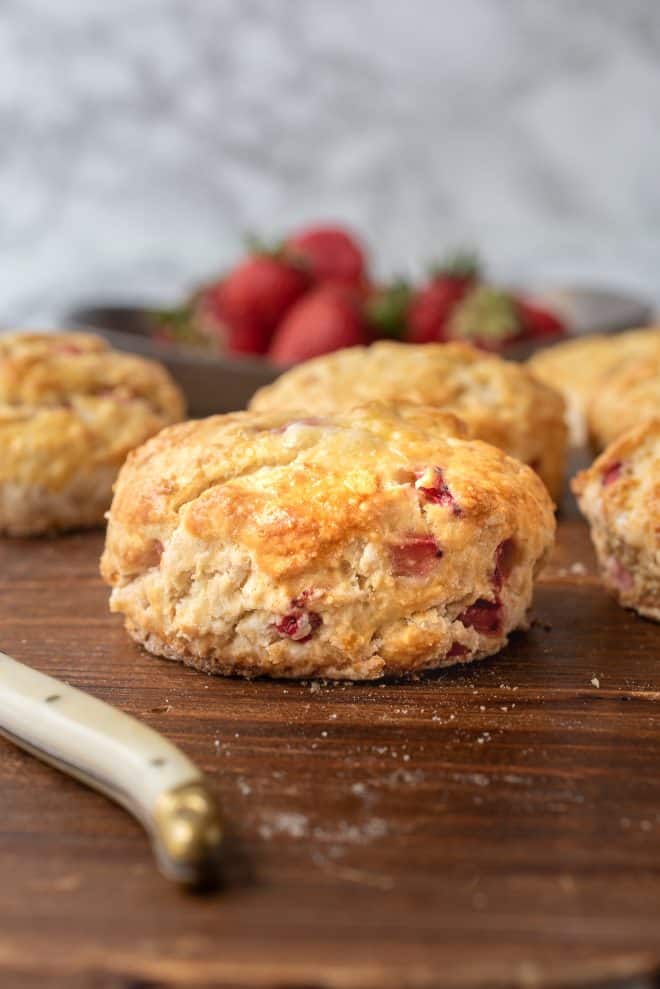
If you’ve tried these Classic English Scones or any other recipe on the blog then don’t forget to rate the recipe and let me know how it turned out in the comments below. I love to hear from my readers!
You can also FOLLOW ME on FACEBOOK, TWITTER, INSTAGRAM and PINTEREST to see daily recipe updates.

Classic English Scones

Flaky and buttery English scones best served with clotted cream and strawberry jam.
Ingredients
- 2 cups (300 grams) all-purpose flour
- 2 ½ teaspoons baking powder
- 1/2 teaspoon salt
- 5 tablespoons (68 grams) unsalted butter, frozen (see note)
- 2 large eggs, room temperature
- 1/2 cup (118 ml) plus 1 teaspoon milk, room temperature
- 2 tablespoons granulated sugar
Instructions
- Preheat oven to 400°F/200°C.
- To a mixing bowl sift the flour, baking powder and salt, mix. Grate the butter into the flour and using your finger tips to rub the butter into the flour (see video for technique) until it forms large crumbles.
- In a separate bowl, whisk 1 egg into ½ cup milk. Make a well in the center of the flour and add the egg/milk mix and sugar. Mix the dough lightly with a fork until it comes together. It should be moist, but not sticky. Add a touch more milk if it is too dry and not holding together.
- Turn the dough onto a lightly floured surface. Shape the dough to 3/4 inch (2 cm) thick round. Do not work the dough too much and do not use a rolling pin.
- Using a non-fluted 2 1/2 inch (5 cm) cookie cutter, dipped in flour, cut rounds pressing straight down, do not twist. Dip the cutter into flour before each cut.
- Line a baking sheet with parchment/baking paper and place the rounds about 1/2 inch (1 ¼ cm) apart.
- Whisk the remaining egg with the 1 teaspoon milk and brush the tops of the scones. Bake for 15 minutes or until golden brown.
- Remove from the oven, transfer to a wire rack to cool completely. Cover with a clean, dry towel while they cool to keep them moist.
Notes
This is to keep the butter as cold as possible so when it hits the hot oven it creates steam and makes the scones flaky.
Nutrition Information
Yield
9Serving Size
1Amount Per Serving Calories 185Total Fat 8gSaturated Fat 4gTrans Fat 0gUnsaturated Fat 3gCholesterol 58mgSodium 320mgCarbohydrates 24gFiber 1gSugar 3gProtein 4g
This nutrition calculation is provided by Nutronix that is only a guideline and not intended for any particular diet.
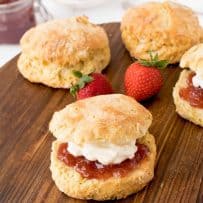
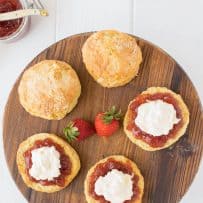
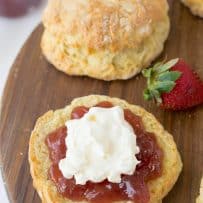
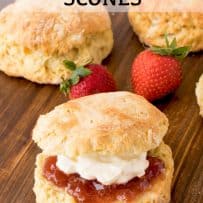

14 Comments on “Classic English Scones”
Thank you for your perfect recipes
1
Hi Janette,
Thanks for this delicious recipe. I tweaked it slightly as I’m allergic to a number of grains. I used a mix of buckwheat flour, ground almonds & tapioca flour. It was really delicious. Next I will try frozen coconut oil in place of the butter.
Thanks again
I’m so happy you were able to adapt the recipe to suit your allergies. Thank you for the feedback.
Whole Foods in USA sells Devon Clotted Cream.
I have made Clotted Cream twice. The two experiences were completely different.
First time exactly 12hrs, lots of liquid. 1 quart only rendered about 1 cup Clotted Cream. Impossible to stack in a jar.
Second time overcooked 45 mins by accident. Totally different end product. No liquid much easier to scoop up and stack drops in jar. Rendered almost 3 cups.
Is there a right or wrong way? Is having no liquid a problem? I much preferred over cooking and having no liquid.
Can the recipe be doubled? I was thinking of making more for the freezer
Yes, this is no problem. Enjoy.
Good Morning Janette,
Just between you and I and the garden gate.
Just read your scone recipe and the comments from readers.
I will give your scones a try next time I bake.
I normally use Mary Berry’s recipe, it always works for me.
A couple of tips though;
Always stir the aluminum free baking powder, before measuring. (Throw that old powder away.)
Grate the cold butter on a box cutter, less time handling the dough. I always add a little sugar once they are brushed with the milk. (I use regular milk but will try the Buttermilk next time.
Put scones side by side, touching each other while baking.
Like you I take them out of the oven when ready, put them on a wire rack then cover them with a clean tea towel. I think this is so important.
By the way I am 88 years old from Edgware in Middx, been in California since 1953.
Still cook and eat the English way, my Mum was Irish, she always added a whole, but peeled apple to her soups it collected the fat,when soup is ready, its taken out and discarded, makes for a lovely clear soup.
So happy I found you,
Warm wishes,
Rosemarie
I’m so happy you found me too. Thank you so much for sharing your tips and enjoy the scones.
I like to add eggs to my scones to, gives a nice flavour.
Hi!!! just wondering how do you work the dough without the rolling pin?
Thank you!
Susana ( Mexico)
Hello Susana, I have seen a wine bottle used, just make sure it is clean 🙂
Yay for your English recipes, Janette!
I made a couple of batches of scones a few weeks back and I just couldn’t get them to rise. I’ll have to try your recipe – interesting that you’ve added an egg!
Can you buy clotted cream in the US? 🙂
I had trouble getting them to rise as well and I just got better results using the egg, which surprised me as well. I am happy to say my local supermarket carries real clotted cream 🙂